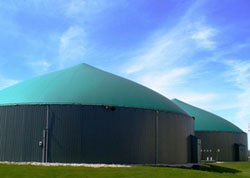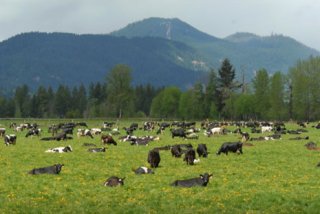Practices to Reduce Methane Emissions from Livestock Manure Management
There are several common manure management practices that can reduce methane emissions. When selecting a manure management practice, one should also consider its impact on other potential greenhouse gas (GHG) emissions (such as nitrous oxide) or sinks (such as carbon sequestration). In general, liquid manure management systems lead to anaerobic conditions and increased methane production, and switching to practices that manage manure in drier, aerobic conditions reduces methane emissions. This overview does not address enteric fermentation or agricultural soils emissions or sinks. The U.S. Greenhouse Gas Inventory provides more information about agricultural emissions and sinks in the US.
| Manure Management Practice | Relative Methane Reductions* |
|---|---|
| Anaerobic Digestion |      |
| Daily Spread |      |
| Pasture-Based Management |      |
| Composting |      |
| Solid Storage |      |
| Manure Drying Practices |      |
| Semi-Permeable Covers, Natural or Induced Crusts |     |
| Decreased Manure Storage Time |     |
| Compost Bedded Pack Barns |    |
| Solid Separation of Manure Solids Prior to Entry into a Wet/Anaerobic Environment |   |
*Notes:
- Methane emissions and reductions calculated based on the methodologies provided in the Inventory of U.S. Greenhouse Gas Emissions and Sinks, the 2006 IPCC Guidelines for National Greenhouse Gas Inventories, and the 2019 Refinement to the 2006 IPCC Guidelines for National Greenhouse Gas Inventories.
- Methane reductions are estimated based on converting from an uncovered anaerobic lagoon in a dry temperate climate. If converting from other scenarios or practices, relative emission reductions would differ.
- Anaerobic digestion reductions assume energy production and include indirect reductions resulting from the avoided use of fossil fuels.
Anaerobic Digestion

| Description | Anaerobic digestion is a process through which microorganisms break down organic matter—such as animal manure, wastewater biosolids, and food wastes—in the absence of oxygen. Anaerobic digestion with biogas flaring or utilization reduces overall methane emissions and provides many benefits. Common designs include covered anaerobic lagoons, plug flow digesters, and complete mix digesters. |
| Best Use Cases |
|
| System Requirements |
|
| Challenges/Limitations |
|
| Potential GHG Emissions Reductions |
|
| Cost Considerations | High capital and operating costs can be offset by the production of electricity, heat, and/or transportation fuel, the injection of biogas into existing natural gas pipelines, and the development of byproducts such as fertilizer or bedding. |
| More Information |
|
Daily Spread

| Description | In a daily spread management practice, manure is removed from a barn and is applied to cropland or pasture daily. |
| Best Use Cases |
|
| System Requirements |
|
| Challenges/Limitations |
|
| Potential GHG Emissions Reductions |
|
| Cost Considerations | There are daily labor and equipment costs associated with this management practice. |
| More Information |
|
Pasture-Based Management

| Description | A pasture-based management system consists of keeping animals on fenced pasture. Animals are rotated between grazing areas to improve the health of the pasture and to spread manure. Manure is left as-is to return nutrients and carbon to the land. |
| Best Use Cases |
|
| System Requirements |
|
| Challenges/Limitations |
|
| Potential GHG Emissions Reductions |
|
| Cost Considerations | Fencing and the purchase of land may be necessary. Labor and capital investment in pasture maintenance should be considered as well. A supplemental feed budget is necessary when the nutrient needs of animals cannot be met solely by grazing. |
| More Information |
|
Composting

| Description | Composting is the aerobic decomposition of manure or other organic material by microorganisms in a managed system. Composting requires air, moisture, and high-nitrogen and high-carbon organic material. Typically, manure and bedding or wood chips are the high-nitrogen and high-carbon materials, respectively. Turning is required to aerate and evenly compost the pile. The process generally takes several weeks to months depending on the level of turning/aeration management. There are various composting methods:
|
| Best Use Cases |
|
| System Requirements |
|
| Challenges/Limitations |
|
| Potential GHG Emissions Reductions |
|
| Cost Considerations | The initial infrastructure, materials, and equipment are the main components of the cost, but regular maintenance is required. The costs may be mitigated by the sale of compost, but the market for compost needs to be considered since demand for compost is often higher near urban areas. |
| More Information |
Solid Storage

| Description | Solid storage is the storage of manure, typically for a period of several months, either in an open area with unconfined piles or stacks or in a dedicated storage facility where the manure is confined within the walls of the facility. Solid storage can be part of a manure management system with solid-liquid separation or manure drying but combining these practices is not required. |
| Best Use Cases |
|
| System Requirements |
|
| Challenges/Limitations |
|
| Potential GHG Emissions Reductions |
|
| Cost Considerations | The costs associated with storing manure in piles or stacks is low, however the costs of constructing dedicated storage facilities are higher. |
| More Information |
|
Manure Drying Practices
| Description | Manure drying involves any of a variety of methods to reduce the liquid content of manure to achieve a solids content of 13 percent or more. Manure drying is commonly used so that the manure can be stored or transported more easily. Drying practices include:
|
| Best Use Cases |
|
| System Requirements |
|
| Challenges/Limitations |
|
| Potential GHG Emissions Reductions |
|
| Cost Considerations | Infrastructure costs for space requirements or specialized buildings vary based on the different manure drying techniques. Additional equipment is necessary to optimize drying time and to spread and collect manure. There are also associated labor costs. |
| More Information |
|
Semi-Permeable Covers, Natural or Induced Crusts
| Description | Semi-permeable covers or natural or induced crusts enclose open manure storage. These covers can reduce methane, ammonia, and odor. Geo-textile, straw, wood chips, and induced or natural crusts can be used in this practice. Induced or natural crusts are a result of biological and physical activity that occurs in the manure. |
| Best Use Cases |
|
| System Requirements |
|
| Challenges/Limitations |
|
| Potential GHG Emissions Reductions |
|
| Cost Considerations | Maintenance, equipment, and materials costs are dependent on the type of cover used. |
| More Information |
|
Decreased Manure Storage Time
| Description | Decreasing manure storage time involves limiting the amount of time manure is stored by processing or transporting it out of a storage facility, such as a slatted floor pit storage, at a reduced storage interval. Reducing the time in storage reduces the time that the stored material is in anaerobic conditions. One option to decrease storage time is to apply the manure to the land consistently during periods of good weather and soil conditions. Daily spreading of manure will have the greatest reduction in methane production but reducing storage time from months to weeks can also have a significant effect. |
| Best Use Cases |
|
| System Requirements |
|
| Challenges/Limitations |
|
| Potential GHG Emissions Reductions |
|
| Cost Considerations | Equipment changes for more frequent manure land application may be needed. There may also be increased labor costs for this technique. |
| More Information |
Compost Bedded Pack Barns
| Description | Compost bedded pack barns are a housing system that include a deep bedding - such wood shavings, sawdust, or other adsorbent bedding materials. Animals can freely roam on the pack and through walkways to access the feeding area. The pack is aerated, usually twice daily, mixing the manure into the pack, providing the animals with a fresh surface. The bedding can be removed and land applied or composted further. This system is generally an alternative to tie or free stalls for dairy cows. |
| Best Use Cases |
|
| System Requirements |
|
| Challenges/Limitations |
|
| Potential GHG Emissions Reductions |
|
| Cost Considerations | A new barn or modification is often required to ensure there is adequate ventilation and space for each animal. Additionally, bedding is necessary to maintain moisture levels. There will be increased labor costs for the management and maintenance of the pack. The cost of a compost bedded pack barn can be less expensive than a traditional liquid storage. |
| More Information |
|
Solid Separation of Manure Solids Prior to Entry into a Wet/Anaerobic Environment

| Description | Solid separation techniques generally fall into two main categories: those that separate solid particles from water based on density, and those that separate solids based on particle size. Solid separation technologies include:
|
| Best Use Cases |
|
| System Requirements |
|
| Challenges/Limitations |
|
| Potential GHG Emissions Reductions |
|
| Cost Considerations |
|
| More Information |
|
